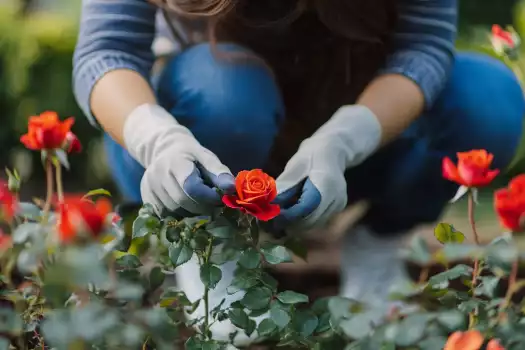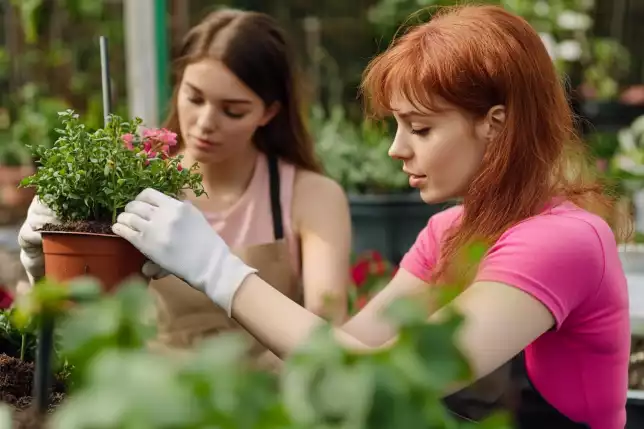Growing roses for gorgeous blooms is easier than you might think with the right tips and care. Roses are a timeless favorite in gardens, known for their stunning flowers and delightful fragrance. This guide covers everything you need to know to grow vibrant, healthy roses that will enhance any garden.

1. What Makes Growing Roses Easy?
Drought Tolerance and Hardiness
Some rose varieties are known for their drought tolerance and resilience, requiring less water and care, making them great for low-maintenance gardens.
Minimal Pruning and Deadheading
Choosing roses that require minimal pruning will simplify care while ensuring consistent blooms throughout the season.
Disease Resistance
Modern rose varieties, like Knockout Roses, are bred for disease resistance, reducing the need for chemical treatments and extra maintenance.
2. Best Rose Varieties for Easy Growing
1. Knockout Roses
Knockout Roses are ideal for beginners due to their hardiness and minimal care requirements. They resist common rose diseases like black spot and powdery mildew.
2. Floribunda Roses
Floribundas bloom in clusters and are highly disease-resistant, perfect for adding abundant color with little effort.
3. Shrub Roses
These varieties are tough and adaptable, requiring minimal pruning and offering long-lasting blooms throughout the season.
3. When and Where to Plant Roses
Best Time to Plant Roses
Plant roses in early spring or late fall for the best root establishment. Avoid planting during extreme heat or cold for optimal growth.
Finding the Ideal Spot for Roses
Choose a location with full sun (at least 6 hours a day) and well-drained soil. Good airflow is crucial to prevent diseases and ensure your roses thrive.

4. Step-by-Step Rose Planting Guide
Step 1: Preparing the Soil
Roses thrive in rich, well-draining soil. Work compost or organic matter into the ground before planting to boost soil fertility and drainage.
Step 2: Planting Techniques
Dig a hole that’s wide and deep enough for the root ball. Place the rose carefully, ensuring the graft union is just above soil level.
Step 3: Mulching for Moisture Retention
Apply 2-3 inches of mulch around your roses to conserve moisture, suppress weeds, and regulate soil temperature.
Learn more about growing roses and expert tips for perfect blooms.
5. Caring for Roses Year-Round
Watering Roses Properly
Water deeply but less frequently to encourage strong root systems. Avoid wetting the foliage to prevent fungal diseases.
Fertilizing Roses
Feed your roses in the spring when new growth appears and again in midsummer for continuous blooms. Use an organic rose fertilizer or compost tea.
Pruning for Better Growth
Prune dead or damaged canes in early spring and remove spent blooms throughout the growing season (deadheading) to encourage fresh growth.
6. Dealing with Common Rose Pests and Diseases
Preventing Aphids and Black Spot
Natural solutions like neem oil can keep aphids and fungal diseases at bay. Increase airflow around plants and water at the base to avoid wet leaves.
Companion Planting for Pest Control
Planting lavender or garlic near your roses can help deter pests naturally, promoting healthier growth without chemical interventions.
7. Winter Care for Roses
Protecting Roses from Frost
Before winter, prune your roses lightly and mulch heavily around the base to protect the roots from freezing. In colder regions, consider covering roses with burlap or rose cones.
8. Expert Tips for Continuous Blooms
Deadheading Roses
Regularly removing spent flowers will promote more blooms throughout the growing season. Cut just above the first set of leaves for best results.
Feeding for Long Blooming Periods
Use a balanced, slow-release fertilizer during the growing season to keep your roses blooming longer. Apply fertilizer every 4-6 weeks for continuous color.
For more low-maintenance flower ideas, check out this guide on indestructible flowers.
9. Final Thoughts: Enjoying Your Rose Garden
Growing roses doesn’t have to be difficult. With the right rose varieties and proper care, you can enjoy gorgeous blooms throughout the season with minimal effort. Follow these expert tips to create a stunning rose garden that will thrive for years to come.
Frequently Asked Questions (FAQ)
Q: How often should I water my roses?
A: Roses need deep watering once or twice a week, depending on the weather and soil type. It’s important to water at the base and avoid wetting the leaves to prevent disease.
Q: What is the best fertilizer for roses?
A: Use an organic fertilizer or balanced rose feed, applied in early spring when new growth starts and again in midsummer. Compost tea or slow-release fertilizers work well.
Q: How do I prevent common diseases like black spot?
A: Ensure good airflow around your roses by spacing them properly, and water at the base of the plant to keep foliage dry. Companion planting with garlic or lavender can help deter pests and diseases.
Q: Can I grow roses in containers?
A: Yes! Roses like Miniature Roses and Patio Roses do well in containers. Be sure to use a large enough pot with good drainage and place them in a sunny spot.
Conclusion: Enjoying Your Rose Garden
Growing roses doesn’t have to be difficult. By selecting the right rose varieties, following proper planting techniques, and caring for them year-round, you’ll enjoy vibrant, gorgeous blooms with minimal effort. With a little care, your roses will flourish and add beauty to your garden for years to come.


1 thought on “Growing Roses for Gorgeous Blooms: Expert Tips Made Easy”